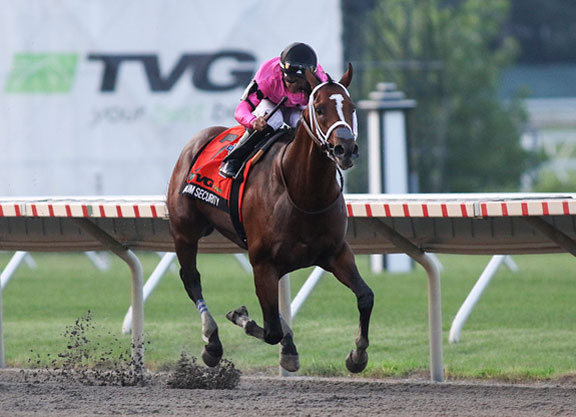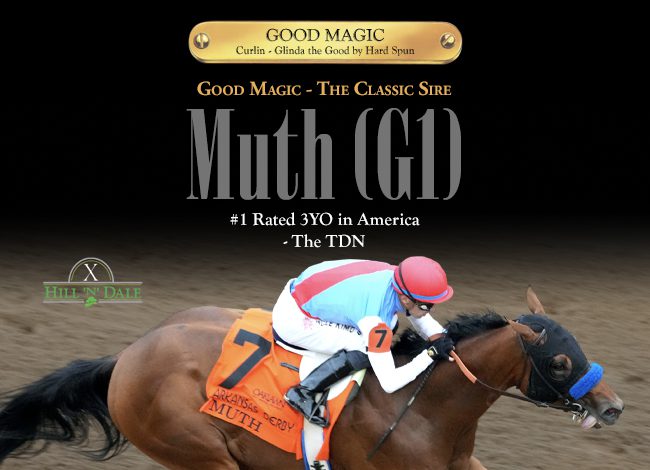The Week in Review, by T.D. Thornton
Maximum Security (New Year's Day) doesn't catch many breaks.
Luckily–for him at least–the gutsy bay is pretty adept at grinding out his own special brand of mojo that nearly always gets his nose down in front at the wire.
I'm not entirely sure that Maximum Security's 1 1/4-length slugfest score in Saturday's GI TVG.com Haskell Invitational edged him any closer to laying claim to an eventual Horse of the Year title, or even to bragging rights of being the current divisional leader of a schizophrenic sophomore class.
But the 5-for-7 former $16,000 maiden-claimer who crossed the finish line first and was controversially disqualified from a front-running win in the GI Kentucky Derby sure gets my vote for the most accomplished elite-level overachiever we've seen in years.
Putting aside for the moment the bizarre heat-related delay and partial cancellation of the card on Monmouth Park's biggest day of the summer (colleague Bill Finley was on the scene and described it in detail here), Maximum Security stood out on Saturday for fighting through three distinct instances of in-race adversity that could have derailed his chances of winning his second Grade I stakes of the year (technically his third if a federal judge ever sides with the colt's owners, who are suing the Kentucky Horse Racing Commission, et al, over the precedent-setting Derby DQ).
The first tactical obstacle Maximum Security had to overcome was at the gate break of the Haskell, when he bounced out alertly from the outside stall in the six-horse race but was denied an inside position by two dueling leaders.
Jockey Luis Saez also couldn't tuck in right behind the speed setup, because another rival had snagged that stalking spot, so he opted for a three-deep position through the clubhouse turn and onto the back straight. It was only the second time in his career that Maximum Security was not leading a quarter mile into the race.
Maximum Security crept closer as the field bunched nearing the half-mile pole, but Saez waited for the stronger of the two duelers, King for a Day (Uncle Mo), to peel away from the pack three-eighths out before cueing his 4-5 favorite to go after the 5-2 shot.
For about half a furlong this tandem accelerated in earnest, but “Max” (in the two path) was already in the process of cracking “King” (at the rail) as they neared the five-sixteenths pole and a fresh challenge loomed in the form of 'TDN Rising Star' Mucho Gusto (Mucho Macho Man), the 3-1 third choice.
This threesome tightened up as the field spun off the far turn, with the tiring King for a Day bailing out of the battle by checking while closest to the fence.
Now the Haskell was clearly down to Maximum Security and Mucho Gusto. If you could have stopped the race right there, knowing that Max already didn't get his own way on the lead and that he had expended a big burst of mid-race energy in 93-degree heat by gunning for first run at the main speed threat–and further knowing that the horse taking dead aim on him was trained by eight-time Haskell winner Bob Baffert–which would have gotten your money to prevail in the final quarter mile?
Mucho Gusto might have been the logical choice. But every time he edged within striking distance through the length of the stretch, Maximum Security dug in and fought harder, incrementally widening the margin so that finally there was daylight (even at 8:14 p.m.) between them at the wire.
Max also survived a stewards' inquiry into the far-turn logjam, but no foul or DQ was ruled.
Trainer Jason Servis told Daily Racing Form Sunday that Maximum Security was “pretty tired” the day after his Haskell score, but that the next-race target would still be the Aug. 24 GI Travers S. if the colt rebounded well in training up at Saratoga. He added that the GI Pennsylvania Derby at Parx Sept. 21 was a secondary option.
Just the knowledge of how sapping the stifling heat was on Saturday might be reason enough for many bettors to try and take a swing against Maximum Security if he starts back on five weeks' rest in the Travers.
But wager against this admirable overachiever at your own peril, because Maximum Security continues to outrun expectations and–more importantly–most of his competition.
Does Lasix reduction help in heat?
Although no one is claiming that several months worth of anecdotal evidence equates to a scientific study, an interesting side note emerged from last Thursday's California Horse Racing Board (CHRB) meeting: The house-rule reduction of the maximum allowable race-day Lasix dosage from 500 mg to 250 mg at Santa Anita the last several months of the spring meet resulted in fewer horses having problems related to heat.
Some context is in order here. Dionne Benson, DVM, the chief veterinary officer for The Stronach Group, which owns Santa Anita, told the CHRB at that meeting that since the board approved the reduced Lasix policy earlier this year, only one horse had an instance of epistaxis, or bleeding from the nostrils.
That one case, Benson said, “is not outside of the numbers that we would expect with full doses on Lasix, so clearly horses are able to run under” the reduced dosages.
When asked by one CHRB member if she was surprised at that result, Benson said no, but added that “I will tell you one thing that I found surprising: We didn't see that many heat exhaustion cases.”
When a CHRB member postulated that might be related to lower-dosed Lasix horses being able to retain more fluids, thus allowing them to better combat extreme heat, Benson said “That's perhaps the case. And hopefully it will be the case in the future.”
Droning on…
One of the aspects of the Haskell inquiry that was debated online in the aftermath of Saturday's non-DQ was the fact that the far-turn spot where King for a Day checked is not very well covered by traditional patrol camera angles. The Monmouth pan shot in that area is partially blocked by infield trees, and the rear-view and head-on shots are not always definitive. Similar blind spots exist at just about every track in the nation.
So what about the idea of using an overhead drone camera to assist in officiating?
Indiana Grand might be the first U.S. Thoroughbred track to test out that idea.
According to an online job posting on Indeed.com that popped up last week, the track is seeking a drone pilot whose chief task will be “capturing quality footage of fast moving horses, while flying steadily at a safe distance away from horses.”
The ad further states that “This job will assist the A/V Department, and will help the Stewards of the Indiana Horse Racing Commission complete their task of determining that each race is run fairly, cleanly, and with integrity. Video from a drone is necessary to cover approximately 100 yards of the race course that is underserved by current video installations ”
Last week TDN emailed Jon Schuster, the track's general manager, asking for details about the concept. That query has yet to be answered. The guess here (forced pun very much intended) is that the drone project is still up in the air.
Not a subscriber? Click here to sign up for the daily PDF or alerts.






